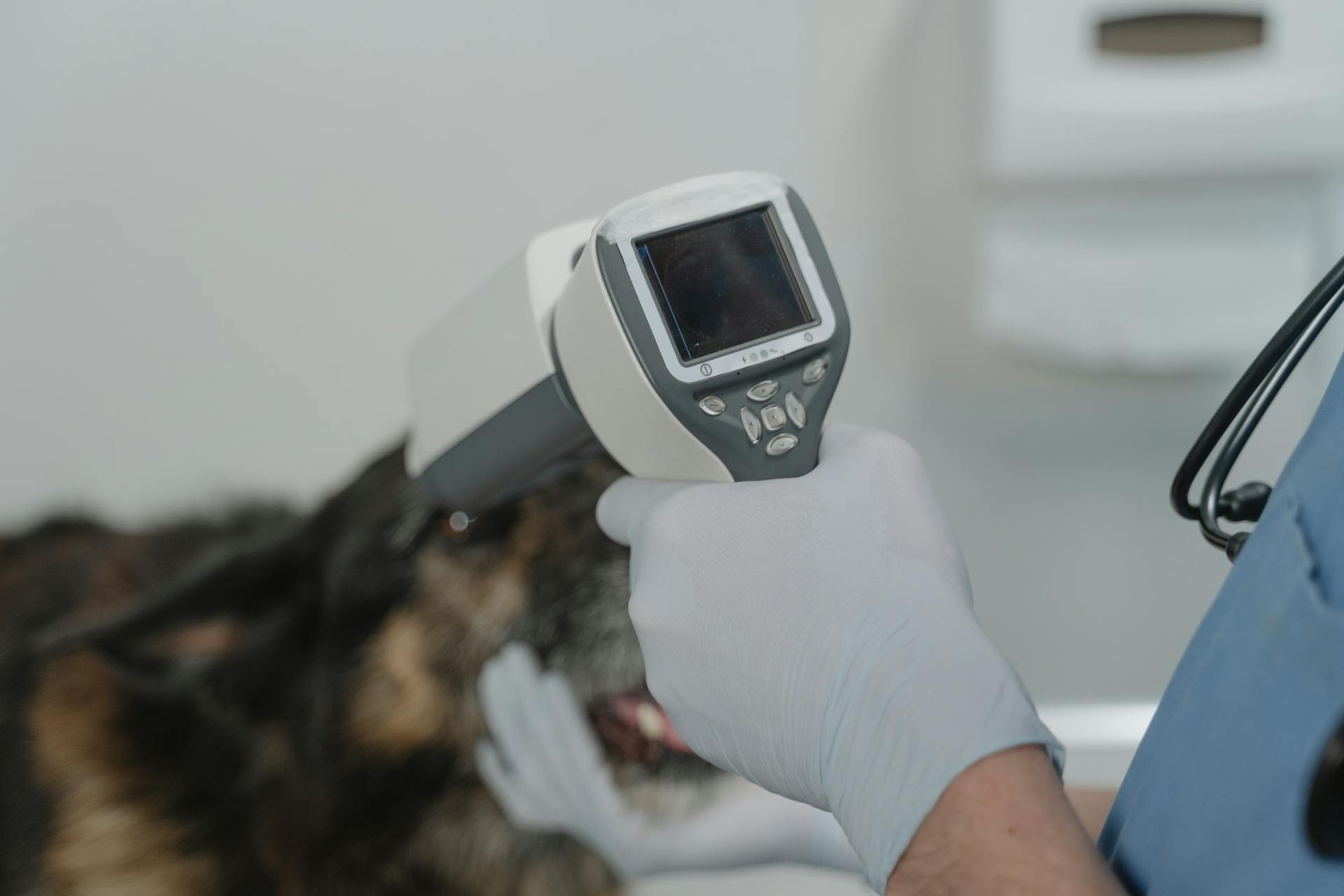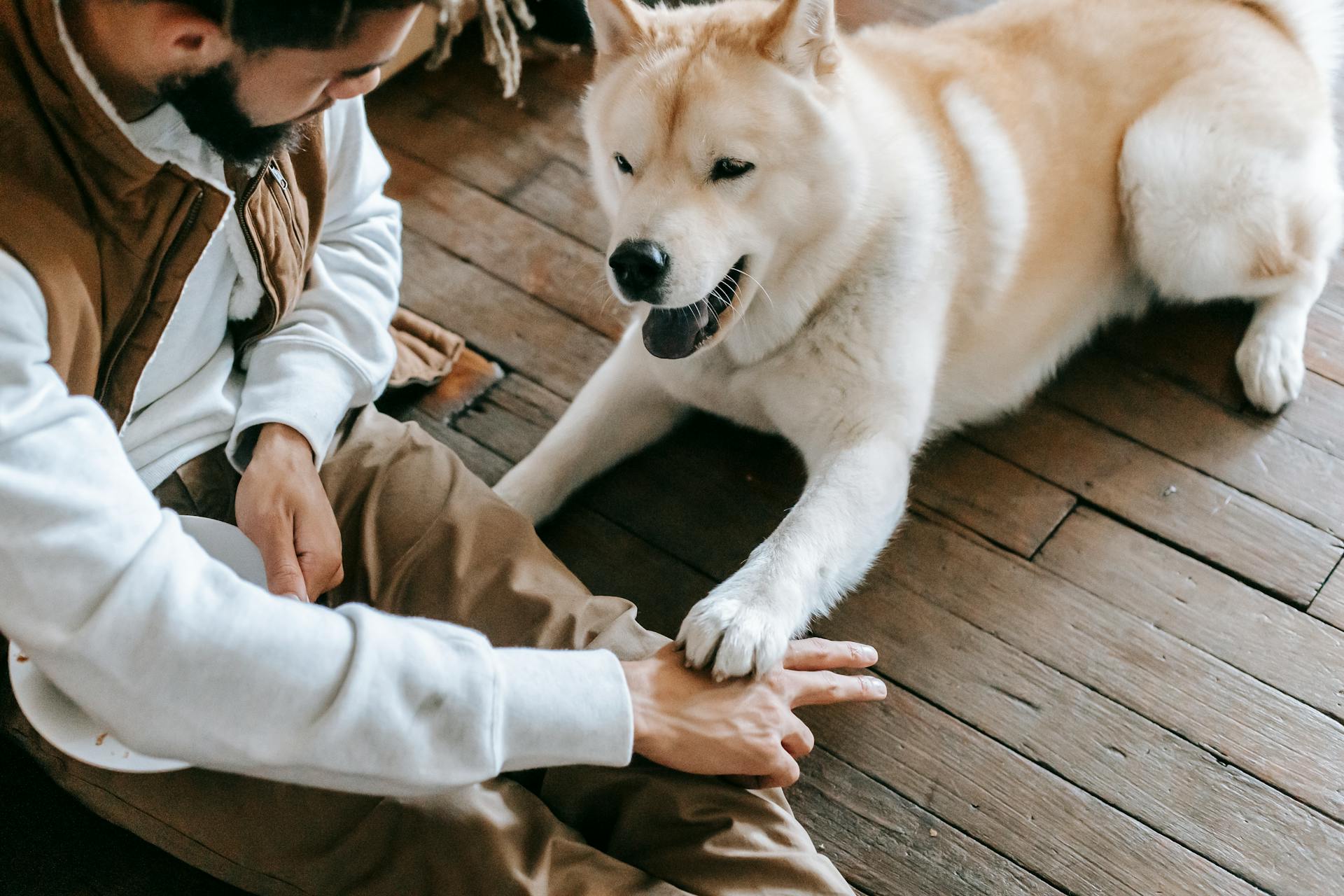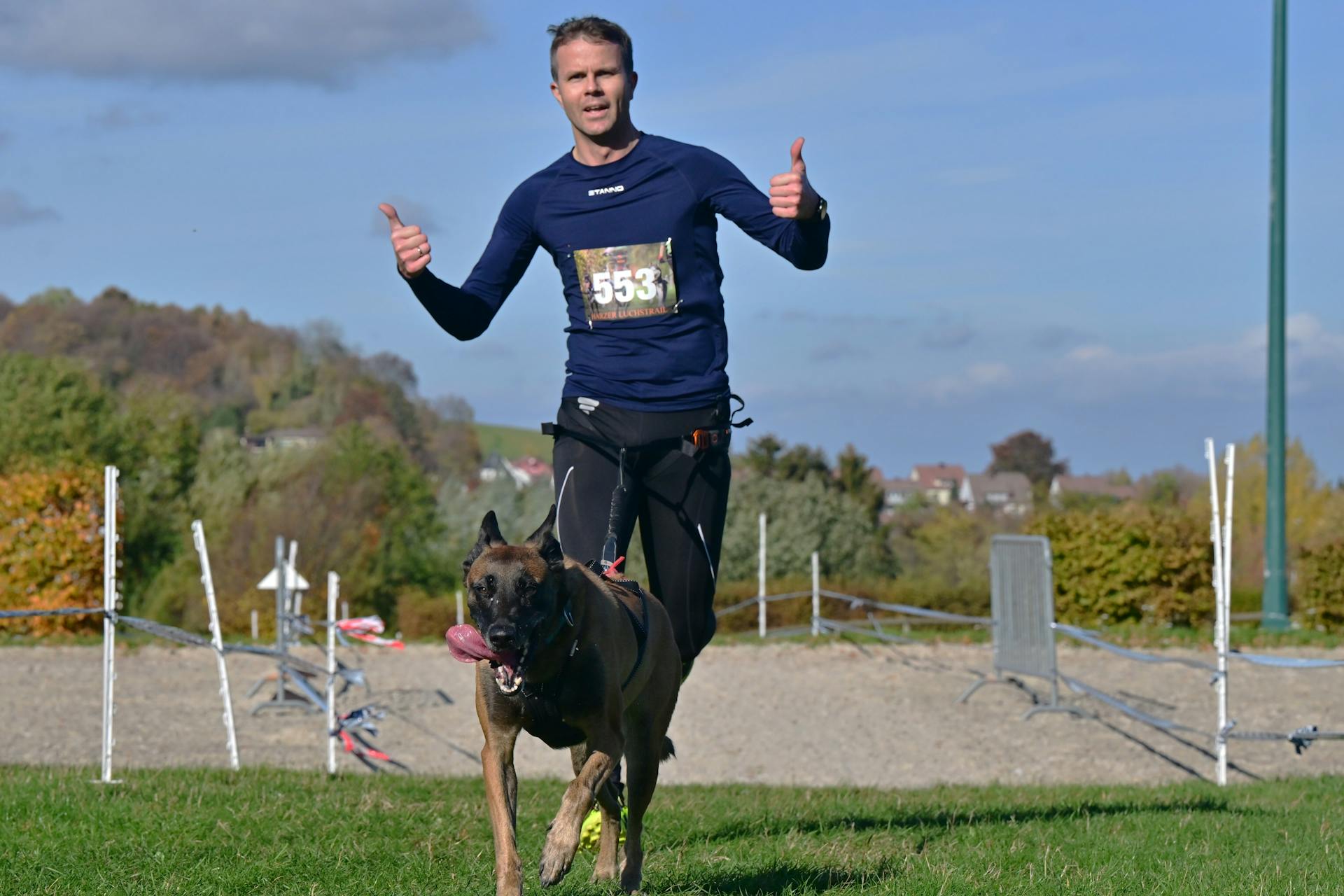
Dominant behavior in dogs is often misunderstood, but it's essential to understand the concept to manage it effectively. Dominant behavior is not the same as aggression, although it can sometimes manifest in aggressive ways.
Dogs don't have the same concept of dominance as humans do, and it's often a result of their natural pack behavior. In the wild, dominant dogs would lead the pack and protect their family, but this behavior doesn't necessarily translate to domesticated dogs.
To understand dominant behavior, it's crucial to recognize the signs, such as raised hackles, a lowered head, and a tense posture. These physical cues can indicate that a dog is feeling dominant or assertive.
You might enjoy: Dominant Female Dog
Poor Obedience Training is a Cause
Poor obedience training is a significant contributor to dog dominance problems. Many obedience classes focus solely on the Learning Phase, neglecting the crucial Correction Phase. This can lead to owners who don't know how to correct their dog's behavior, resulting in dominance issues.
See what others are reading: Dog Training Basic Obedience Lesson Plan
The Learning Phase is just the first step in obedience training. It's where you teach your dog the meaning of a command in a distraction-free environment, using motivational methods like food or toy rewards. However, this phase only lays the foundation for more advanced training.
The Correction Phase is essential for teaching your dog that it will be corrected if it doesn't follow a command. This phase is often skipped in large pet warehouse classes, which can lead to dominant dog problems. In fact, this is one of the leading causes of dominant dog problems.
To illustrate the importance of the Correction Phase, consider the following stages of training:
By skipping the Correction Phase, owners can inadvertently empower their dog, leading to dominance issues. This can be particularly problematic when dealing with adult dogs or dogs that have matured without proper training.
Recognizing Dominance
Dogs may display dominance behavior in response to their relationships with family members and other dogs in their pack. In a dog pack, there is often an established hierarchy with one dog acting as the leader or alpha.
Readers also liked: Pack Leader Dog Training
A dominant dog may exhibit behaviors such as guarding doorways, mounting, or competing for attention to establish order or protect its resources. If your dog is doing this, it may be trying to assert its dominance over you.
Signs of a dog showing dominance over its owner may include asserting physical control, such as constantly leading during walks or pushing their owner around. Dominant dogs may also display possessive behavior towards food, toys, and even family members.
Excessive barking or growling, disobedience, and aggressive body language can signal dominance issues. If you notice these behaviors in your dog, it's essential to address them to prevent further problems.
An alpha dog typically displays confidence and leadership qualities, such as maintaining a calm demeanor and controlling resources like food and toys.
Recommended read: Dog Training with Toys
Influence on Family and Packs
Dominance behavior in dogs can be influenced by their relationships with family members and other dogs in their pack. In a dog pack, there is often an established hierarchy, with one dog acting as the leader or alpha.
Other dogs in the pack may adopt submissive behaviors in the presence of the alpha dog, while the alpha dog may display dominance to maintain order and control. This is similar to what happens in human households, where a dog may perceive family members as part of its pack.
If the dog feels that it needs to assert its dominance over family members to establish order or to protect its resources, it may exhibit behaviors such as guarding doorways, mounting, or competing for attention. People with dominant dogs often notice that their children are out of control, which can exacerbate the problem.
Teaching a dominant adult male dog that a child is the pack leader is impossible. The goal should be to teach the dog that one of the pack leader rules is to not show aggression to children and if need be, to stay away from the children. This becomes an obedience issue.
Broaden your view: Impulse Control Dog Training
Signs of Dominance
Dominance behavior in dogs can manifest in various ways, including headstrong, pushy, or stubborn behavior. Dominant behaviors in dogs include inappropriate mounting, licking, being demanding, or even begging.
Some common signs of a dog showing dominance over its owner include asserting physical control, such as constantly leading during walks or pushing their owner around. Dominant dogs may also display possessive behavior towards food, toys, and even family members.
Excessive barking or growling, disobedience, and aggressive body language can signal dominance issues. A dominant dog may display assertive body language, control resources like food and toys, or initiate play with other dogs.
Invading your personal space without invitation, such as climbing onto your bed or occupying your lap, can be a subtle way of dogs taking over the leadership. Dogs that show aggression towards certain visitors to the house are asserting a form of dominance.
A dog that shows aggression towards family friends is not being cute or protective, but rather asserting dominance. Teaching your dog that it's not acceptable to show aggression to children can be an obedience issue, but it's not possible to teach a dominant adult male dog that a child is the pack leader.
Here's an interesting read: Sign Language for Dog Training
Training and Management
Consistency is key when it comes to managing dominant behavior in dogs. Establish clear boundaries and rules, and consistently enforce them to show your dog that you're in charge.
Consistent enforcement of rules and boundaries aids in managing dominant behavior in dogs. Dog owners should establish clear limitations on their pets' behavior and consistently enforce these rules.
A reliable training program introduced early on can save dogs and dog owners from the problems of dominant behavior. Work with a professional dog trainer to improve your training experience.
To correct dominant behavior in dogs, it is crucial to establish clear boundaries and provide consistent training. Reinforcing desired behaviors with rewards, such as treats and praise, can effectively reshape your dog's behavior.
Consistent rules also apply to interactions outside the home, such as during walks, where the use of a leash can help establish and maintain control. Direct eye contact with a dominant dog can be interpreted as a challenge, so it is essential to maintain an assertive, but non-confrontational, posture during training sessions or when issuing commands.
For your interest: Crate Training during the Day
Establishing Consistent Boundaries
By following these guidelines, you can establish a consistent and effective training program to manage your dog's dominant behavior.
Asserting Boundaries
Establishing clear boundaries is essential in dog dominance training. Consistency is key, as it helps reinforce the rules you've set.
Inconsistent enforcement of rules can confuse your dog and undermine your authority. Direct eye contact with a dominant dog can be interpreted as a challenge, so it's essential to maintain an assertive, but non-confrontational, posture during training sessions or when issuing commands.
Setting clear boundaries around furniture, bed, and meal time can help reinforce your position as the authority figure in the household. This is crucial in managing dominant behavior in dogs.
Consistent rules also apply to interactions outside the home, such as during walks, where the use of a leash can help establish and maintain control. Establishing consistent boundaries not only helps curb dominant behavior but also fosters respect and trust between the dog and its owner.
By consistently enforcing limitations and promoting submission, dog owners can create a harmonious environment where both they and their pets can thrive.
Consider reading: What Are the 5 Golden Rules of Dog Training
Early Intervention
Early Intervention is key to preventing dominance issues in dogs. Ignoring the initial signs of dominance can allow the problem to escalate, making it harder to address later on.
Dogs often give subtle cues when they're testing their boundaries and asserting dominance, such as pushing their way to the front during walks or growling when asked to give up a toy.
It's essential to address these behaviors promptly with appropriate training and correction to prevent them from becoming ingrained patterns of dominance.
In fact, it's rare for a puppy younger than 10 months to show signs of dominant handler aggression, but new puppy owners often mistakenly confuse prey drive with dominance.
Puppies play with their littermates by using their mouth, and this behavior can be redirected with food or toys, but it's crucial to teach them manners and human rules.
By focusing on your dog's behavior within the home environment, you'll be better equipped to help them become less aggressive when they venture outdoors.
Proper socialization during a dog's early life contributes significantly to its personality and behavioral traits, and a lack of socialization can result in insecure dogs that may display heightened dominance behavior.
Check this out: Puppy Mill Dogs Behavior
Common Mistakes and Challenges
One of the most significant challenges in dog dominance training is recognizing and addressing underlying issues that can lead to dominance behaviors.
Physical punishment can actually make dominance behaviors worse, as it can create anxiety and fear in dogs, leading to more aggressive behavior.
Some owners may inadvertently reinforce dominance behaviors by giving in to their dog's demands, which can be a result of not establishing clear boundaries and rules from the start.
Establishing a consistent routine and setting clear boundaries is crucial in preventing dominance behaviors from developing in the first place.
Expand your knowledge: Canine Dominance Behavior
Common Owner Mistakes
As an investor, it's easy to get caught up in the excitement of buying a property, but failing to conduct thorough research on the local market can lead to costly mistakes.
Ignoring the condition of the property's major systems, such as the roof and HVAC, can result in expensive repairs down the line.
Many investors assume that a property's value will always increase, but this isn't always the case. In fact, the article notes that the value of a property can fluctuate based on market conditions.
Not having a clear plan for renovations or repairs can lead to delays and cost overruns. For example, the article highlights the importance of creating a detailed budget and timeline for projects.
Some investors underestimate the importance of regular property inspections, which can help identify potential issues before they become major problems. Regular inspections can also help investors stay on top of maintenance and repairs.
Discover more: Do Dog Diapers Help with Potty Training
Denial
Denial is a common mistake that can hinder progress and success. It's a natural response to failure or criticism, but it can also be a major obstacle to learning and growth.
Ignoring feedback is a form of denial, and it can lead to stagnation. In fact, a study found that ignoring feedback can reduce productivity by up to 50%.
Denial can also manifest as making excuses or blaming others. This can be a way to avoid taking responsibility for one's actions and can lead to a lack of accountability.
On a similar theme: How to Stop Staffy Pulling on Lead

Making excuses is a common defense mechanism, but it can also be a sign of underlying issues. For example, a person who consistently makes excuses for their lack of progress may be struggling with procrastination or a fear of failure.
Denial can be a difficult habit to break, but it's not impossible. By acknowledging the problem and taking steps to address it, individuals can overcome denial and achieve their goals.
Specific Behaviors
Dominant dogs often assert physical control, leading during walks or pushing their owner around. They may also display possessive behavior towards food, toys, and family members.
Excessive barking or growling, disobedience, and aggressive body language can signal dominance issues in dogs. Head bumping is a show of dominance, where the dog bumps their head against their owner or another dog to assert their dominance.
In social situations, an alpha dog will often act unprovoked and assert their dominance, controlling resources like food and toys, and initiating play with other dogs.
Indicates Maturity

Between 15 and 36 months of age, a dog's behavior can indicate maturity, with most common signs appearing around 18 months.
This is when a dog's instincts tell them to assume a rank within the pack, and if they don't receive proper training, they may start to display dominance behaviors.
Guarding toys, laying on the bed or furniture whenever they want, and other similar behaviors can be a sign that a dog is trying to establish a higher pack position.
If a dog is displaying these behaviors, it's essential to address the issue before it becomes a serious problem.
Dogs that growl at their food bowl or when you take toys away are often fearful due to past treatment or don't respect your position as a higher social rank.
Growling is a warning or challenge, and it's often accompanied by subtle body postures that owners may miss.
It's better to have a dog that growls than one that strikes with little warning, so it's crucial to understand the underlying reasons for the growling and find a solution to prevent it.
By controlling the environment and addressing the root cause of the behavior, you can prevent problems and strengthen your bond with your dog.
Related reading: Position Box Dog Training
Recognizing Behaviors
Recognizing behaviors is a crucial step in understanding your dog's needs and establishing a harmonious relationship. Dominance behavior in dogs is a natural aspect of their social structure, originating from their ancestral background as pack animals.
Some common dominant behaviors in dogs include inappropriate mounting, licking, being demanding, or even begging. These actions may illustrate a dog's attempt to assert itself as the "pack leader" within a household.
Dogs may also display dominant behavior by invading your personal space, such as climbing onto your bed without an invitation or occupying your lap without consent. This can be a subtle way of showing dominance.
A dominant dog may also use body language to assert its dominance, such as standing tall with its head held high and a stiff body posture. This stance can be a serious warning that the dog is prepared to defend its position.
Other signs of dominance include assertive or aggressive behavior towards humans or other animals, as well as possessive behavior towards food, toys, and even family members. Excessive barking or growling can also signal dominance issues.
Broaden your view: Dog Training without Treats

Here are some common signs of dominant behavior in dogs:
- Inappropriate mounting
- Licking
- Being demanding
- Begging
- Invading personal space
- Standing tall with head held high and stiff body posture
- Assertive or aggressive behavior
- Possessive behavior
- Excessive barking or growling
It's essential to recognize these behaviors and address them appropriately to maintain a harmonious and balanced relationship with your pet.
Treatment and Strategies
First, it's essential to consult with a veterinarian to rule out any underlying medical issues that may be contributing to your dog's dominance behavior. This is the first step in addressing the issue.
Behavior modification is a helpful method in managing dominance issues. By training your dog to exhibit appropriate behaviors using positive reinforcement, you can encourage good behavior and discourage unwanted actions.
Obedience training is another effective way to teach your dog and owner how to communicate effectively. This can foster a healthy bond between them and reduce the need for a dog to assert its dominance.
Environmental management is also crucial in minimizing dominance behaviors. Providing separate feeding areas or specific sleeping spaces for each dog in a multi-dog household can alleviate tension.
Intriguing read: Cockapoo Behavior Issues
Here are some treatment options that may be helpful:
- Behavior modification: Training your dog to exhibit appropriate behaviors using positive reinforcement.
- Obedience training: Enrolling your dog in obedience classes to teach effective communication.
- Environmental management: Structuring your dog's environment to reduce stress and competition.
- Seeking professional help: Consulting a professional dog behaviorist for tailored advice and treatment plans.
If your dog's dominance behavior persists despite attempts to address it, don't hesitate to seek professional help. A professional dog behaviorist can provide you with a customized plan to address the issue.
Frequently Asked Questions
Is it OK to assert dominance over a dog?
Asserting dominance over a dog can actually increase their fear and undermine your relationship, making it a counterproductive approach to dog training. Instead, focus on building trust and clear communication with your dog.
Sources
- Dealing with the Dominant Dog (leerburg.com)
- Dominance Behavior in Dogs: Understanding and ... (roguepetscience.com)
- How to Handle a Dominant Dog: 8 Powerful Training ... (theonlinedogtrainer.com)
- Steven R. Lindsay’s Handbook of Applied Dog Behavior and Training (amazon.com)
- Training A Dominant Cane Corso (sanroccocanecorso.com)
Featured Images: pexels.com


